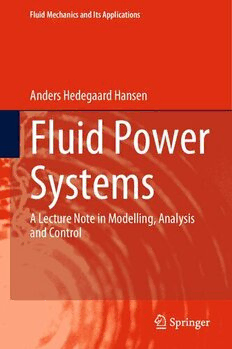Table Of ContentFluid Mechanics and Its Applications
Anders Hedegaard Hansen
Fluid Power
Systems
A Lecture Note in Modelling, Analysis
and Control
Fluid Mechanics and Its Applications
FoundingEditor
RenéMoreau
Volume 129
SeriesEditor
AndréThess,GermanAerospaceCenter,InstituteofEngineering
Thermodynamics,Stuttgart,Germany
The purpose of this series is to focus on subjects in which fluid mechanics plays
a fundamental role. As well as the more traditional applications of aeronautics,
hydraulics,heatandmasstransferetc.,bookswillbepublisheddealingwithtopics,
which are currently in a state of rapid development, such as turbulence, suspen-
sions and multiphase fluids, super and hypersonic flows and numerical modelling
techniques.Itisawidelyheldviewthatitistheinterdisciplinarysubjectsthatwill
receive intense scientific attention, bringing them to the forefront of technological
advancement. Fluids have the ability to transport matter and its properties as well
as transmit force, therefore fluid mechanics is a subject that is particulary open to
crossfertilisationwithothersciencesanddisciplinesofengineering.Thesubjectof
fluidmechanicswillbehighlyrelevantinsuchdomainsaschemical,metallurgical,
biologicalandecologicalengineering.Thisseriesisparticularlyopentosuchnew
multidisciplinarydomains.Themedianlevelofpresentationisthefirstyeargraduate
student.Sometextsaremonographsdefiningthecurrentstateofafield;othersare
accessibletofinalyearundergraduates;butessentiallytheemphasisisonreadability
andclarity.
Springer and Professor Thess welcome book ideas from authors. Potential
authorswhowishtosubmitabookproposalshouldcontactDr.MayraCastro,
SeniorEditor,SpringerHeidelberg,e-mail:mayra.castro@springer.com
Indexed by SCOPUS, EBSCO Discovery Service, OCLC, ProQuest Summon,
GoogleScholarandSpringerLink
Anders Hedegaard Hansen
Fluid Power Systems
A Lecture Note in Modelling, Analysis
and Control
AndersHedegaardHansen
AAUEnergy
AalborgUniversity
Aalborg,Denmark
ISSN 0926-5112 ISSN 2215-0056 (electronic)
FluidMechanicsandItsApplications
ISBN 978-3-031-15088-3 ISBN 978-3-031-15089-0 (eBook)
https://doi.org/10.1007/978-3-031-15089-0
©TheEditor(s)(ifapplicable)andTheAuthor(s),underexclusivelicensetoSpringerNature
SwitzerlandAG2023
Thisworkissubjecttocopyright.AllrightsaresolelyandexclusivelylicensedbythePublisher,whether
thewholeorpartofthematerialisconcerned,specificallytherightsoftranslation,reprinting,reuse
ofillustrations,recitation,broadcasting,reproductiononmicrofilmsorinanyotherphysicalway,and
transmissionorinformationstorageandretrieval,electronicadaptation,computersoftware,orbysimilar
ordissimilarmethodologynowknownorhereafterdeveloped.
Theuseofgeneraldescriptivenames,registerednames,trademarks,servicemarks,etc.inthispublication
doesnotimply,evenintheabsenceofaspecificstatement,thatsuchnamesareexemptfromtherelevant
protectivelawsandregulationsandthereforefreeforgeneraluse.
Thepublisher,theauthors,andtheeditorsaresafetoassumethattheadviceandinformationinthisbook
arebelievedtobetrueandaccurateatthedateofpublication.Neitherthepublishernortheauthorsor
theeditorsgiveawarranty,expressedorimplied,withrespecttothematerialcontainedhereinorforany
errorsoromissionsthatmayhavebeenmade.Thepublisherremainsneutralwithregardtojurisdictional
claimsinpublishedmapsandinstitutionalaffiliations.
ThisSpringerimprintispublishedbytheregisteredcompanySpringerNatureSwitzerlandAG
Theregisteredcompanyaddressis:Gewerbestrasse11,6330Cham,Switzerland
Preface
Withthislecturenotetheauthorstrivesforaneasilyaccessiblenotecoveringsome
of the fundamental topics in fluid power technology. The main objectives are to
enhance the reader’s learnings and depth of understandings in the exciting area
of fluid power technology—and to achieve these goals, significant space is allo-
cated for detailed derivations of formulas that form the basis of the theory. After
successfulcompletionofthisnotethereaderknowshowtoproperly(i)designbasic
fluidpowersystems,(ii)constructlumpedparametermodelsofsimplefluidpower
systems, (iii) perform frequency analysis of fluid power components and systems
and (iv) develop controllers for fluid power systems. The note mainly focusses on
mathematical modelling and analysis of fluid power components and systems, i.e.
practicalissuessuchasworkingprinciplesandconstructionofcomponentsarenot
treated in details. Neither are system topology selection nor sizing of components
usingdesignstandardstreatedinthisnote.
The text is organised in four main parts that mildly overlap with each other:
I Physics of Fluid, II Fluid Power Components, III Fluid Power Systems and IV
LearningbyDoing.
The topics in Part I Physics of Fluids focus on giving the reader a basic under-
standing of fluid mechanics related to fluid power technologies. Special focus is
placedonmodellingoffluidflowthroughrestrictions,viscousforcesinfluidflow
andhowchangesinfluidmomentummayimpactcomponentsandsystems.
InthePartIIFluidPowerComponents,themostimportantandcommonlyused
componentsareintroduced.Emphasisisplacedoncomponentmodellingandusing
thederivedmodelsthefunctionofeachcomponentisillustrated.Aftercompletion
ofPartII,thereaderhasatoolboxofcomponentknowledgethatcanbeusedtoput
togetherasystemthatcanperformacertaintask.
ThethirdPartIIIFluidPowerSystemsgivesanin-depthpresentationofsystem
modellingandsystemanalysisfollowedbyadiscussionofclosed-loopcontroltech-
niquesapplicableinfluidpowersystems.Timedomainlumpedparametermodelsare
developedforafewexamplesystems.Basedontimedomainmodels,linearmodels
are constructed for the purposes of both frequency domain analysis and controller
design.PartIIIconcludeswithachapterintroducinga“cookbook”approachtofluid
v
vi Preface
powersystemdesign,whichallowsthedesignengineertoderiveaninitialsystem
designinasystematicway.
ThePartIVLearningbyDoingisthemostimportantinstrivingfortheobjectives
of learning and understanding topics of fluid power technology. Part IV is filled
withexercises,solutionexamplesandsolutionstrategies.Theauthortrulybelieves
that the knowledge gained from this part of the note is vital for the fluid power
technologystudent:Onemayreadthethreepriorpartsandgetanideaofthetheories
andmethods,butfortrueandprofoundlearningonemustacquirethetheoryby(i)
carefullystudyingofexplanatoryexamples,(ii)independentlysolveexercisesand
(iii)becomeproficientintheartofevaluatingthevalidityandsoundnessofresults.
Aalborg,Denmark AndersHedegaardHansen
January2023 AssociateProfessor
Contents
1 Introduction—It’sJustaGear .................................. 1
1.1 HydrodynamicsVersusHydrostatics ....................... 1
1.1.1 KineticPowerandHydrodynamics ................. 2
1.1.2 Pascal’sPrincipleandHydrostatics ................. 2
1.1.3 ThreeHydrostaticSystems ........................ 3
1.2 HydraulicSystemsVersusFluidPowerSystems ............. 6
1.3 UnitsinFluidPowerSystems ............................. 6
PartI PhysicsofFluid
2 FluidParameters .............................................. 11
2.1 Viscosity ............................................... 11
2.1.1 ViscosityModels ................................ 13
2.1.2 ViscousForceDuetoFluidFlow ................... 14
2.2 FluidDensityandCompressibility ......................... 17
2.2.1 EquationofStateforaFluid ...................... 17
2.2.2 PressureDependentDensityandBulkModulus
ofFluid-AirMixture ............................. 18
2.2.3 Summery ....................................... 21
Reference ..................................................... 23
3 FluidsMechanics .............................................. 25
3.1 ConservationofMass .................................... 25
3.1.1 ControlVolumeApproach ........................ 26
3.1.2 ContinuityEquation—DifferentialForm ............ 28
3.2 MomentumofFluids—NewtonII.Law .................... 30
3.2.1 DifferentialForm—CartesianCoordinates ........... 31
3.2.2 MomentumEquationofaFluid .................... 35
3.2.3 ConservationofMomentum—ControlVolume
Form ........................................... 36
3.3 Euler’sEquationsofMotion—InviscidFlow ................ 39
vii
viii Contents
3.4 ViscousFlow ........................................... 39
3.4.1 Navier-StokesEquations—IncompressibleFluid ..... 40
4 FlowThroughRestriction ...................................... 43
4.1 TurbulentorLaminar—ReynoldsNumber .................. 43
4.2 FlowinaPipe .......................................... 44
4.2.1 FromNavier-StokesEquation ..................... 45
4.2.2 FromForceBalance .............................. 47
4.2.3 VolumeFlow .................................... 48
4.2.4 TurbulentFlowinPipes .......................... 49
4.2.5 SummaryofFlowinPipe ......................... 50
4.3 FlowinGaps—LeakageFlows ............................ 51
4.3.1 FromForceBalance .............................. 51
4.3.2 VolumeFlow .................................... 53
4.3.3 VelocityProfilefromNaiver-StokesEquation ........ 54
4.3.4 SummaryonLaminarFlowBetweenParallel
Plates .......................................... 55
4.4 TheOrificeEquation .................................... 56
4.4.1 LaminarVersusTurbulentOrificeFlow ............. 59
Reference ..................................................... 61
PartII FluidPowerComponents
5 FluidPowerPumps ........................................... 65
5.1 DisplacementPumps .................................... 65
5.1.1 SinglePistonPump .............................. 66
5.2 TheGeneralPumpModel—SteadyState ................... 66
5.2.1 IdealPumpModel ............................... 67
5.2.2 Non-idealPumpModel ........................... 68
5.2.3 SummaryonGeneralPumpModel ................. 71
5.3 PumpTypes ............................................ 72
5.3.1 GearPumps ..................................... 72
5.3.2 VanePumps .................................... 73
5.3.3 PistonPumps ................................... 73
5.3.4 DiscreteDisplacementPumps ..................... 75
6 RotaryActuator—Motors ..................................... 77
6.1 MotorModels .......................................... 77
6.1.1 IdealMotorModel ............................... 77
6.1.2 Non-idealMotorModel .......................... 78
7 LinearActuators—Cylinders ................................... 81
7.1 DifferentialCylinder ..................................... 81
7.1.1 Modelling ...................................... 83
7.1.2 SteadyStateModel .............................. 86
7.1.3 Summary ....................................... 87
7.2 Multi-chamberCylinder .................................. 88
Contents ix
8 ControlElements—Valves ..................................... 91
8.1 GeneralValveModels ................................... 92
8.2 DirectionalValves ....................................... 92
8.2.1 CheckValve .................................... 93
8.2.2 On-OffValves ................................... 94
8.2.3 DirectionalSpoolValve .......................... 96
8.2.4 FlowForceonSpoolValve ........................ 99
8.2.5 ServoValves .................................... 102
8.3 PressureControlValves .................................. 108
8.3.1 PressureRelief .................................. 109
8.3.2 PressureReduction .............................. 111
8.3.3 PressureControl ................................. 113
8.4 FlowControlValves ..................................... 115
8.4.1 ThrottleValve ................................... 116
8.4.2 CaseIllustration—ThrottleValves .................. 117
8.4.3 PressureCompensatedFlowControlValve .......... 119
8.4.4 Pressure Compensated Flow Control
Valve—Bypass .................................. 122
8.5 PressureCompensatedProportionalValves ................. 126
References .................................................... 127
9 Accumulators ................................................. 129
9.1 PistonAccumulator ..................................... 129
9.1.1 MassLoadedPistonAccumulators ................. 129
9.1.2 SpringLoadedPistonAccumulators ................ 131
9.1.3 GasLoadedPistonAccumulators .................. 131
9.2 BladderAccumulator .................................... 132
9.3 DiaphragmAccumulator ................................. 133
10 FluidPowerTransmissionLines ................................ 135
10.1 SteadyStateTransmissionLineModel ..................... 136
10.2 DynamicTransmissionLineModel ........................ 137
10.2.1 LumpedParameterModel ......................... 137
10.3 FluidPowerPipesandHoses ............................. 139
10.3.1 ConstructionofHoses ............................ 140
PartIII FluidPowerSystems
11 ModellingFluidPowerSystems ................................ 143
11.1 Models ................................................ 143
11.1.1 TimeDomainModel—Non-linear ................. 144
11.1.2 ReducedOrderModel ............................ 145
11.1.3 LinearModel—TimeDomain ..................... 146
11.2 Motor-ValveDrive ...................................... 148
11.2.1 TimeDomainModel ............................. 148

